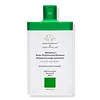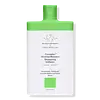What's inside
What's inside
 Benefits
Benefits

 Concerns
Concerns

 Ingredients Side-by-side
Ingredients Side-by-side

Water
Skin ConditioningSodium Cocoyl Isethionate
CleansingSodium Lauroyl Methyl Isethionate
CleansingSodium Lauroamphoacetate
CleansingGlycerin
HumectantCocamide Mipa
EmulsifyingCetyl Alcohol
EmollientPPG-3 Benzyl Ether Myristate
EmollientCaprylic/Capric Triglyceride
MaskingCoconut Acid
CleansingPolyester-37
Skin ConditioningSclerocarya Birrea Seed Oil
HumectantSilk Amino Acids
HumectantHydrolyzed Silk
HumectantSunflower Seed Oil Glycerides
EmollientSericin
Skin ConditioningDisunfloweroylethyl Dimonium Chloride
Lauryl Lactyl Lactate
Skin ConditioningTrisodium Ethylenediamine Disuccinate
Vanilla Planifolia Fruit Extract
Skin ConditioningCitric Acid
BufferingPolyquaternium-10
Polyquaternium-7
Acrylates/C10-30 Alkyl Acrylate Crosspolymer
Emulsion StabilisingCaprylyl Glycol
EmollientSodium Isethionate
CleansingSodium Benzoate
MaskingEthylhexylglycerin
Skin ConditioningHexylene Glycol
EmulsifyingPhenoxyethanol
PreservativePotassium Sorbate
PreservativeBenzyl Alcohol
PerfumingWater, Sodium Cocoyl Isethionate, Sodium Lauroyl Methyl Isethionate, Sodium Lauroamphoacetate, Glycerin, Cocamide Mipa, Cetyl Alcohol, PPG-3 Benzyl Ether Myristate, Caprylic/Capric Triglyceride, Coconut Acid, Polyester-37, Sclerocarya Birrea Seed Oil, Silk Amino Acids, Hydrolyzed Silk, Sunflower Seed Oil Glycerides, Sericin, Disunfloweroylethyl Dimonium Chloride, Lauryl Lactyl Lactate, Trisodium Ethylenediamine Disuccinate, Vanilla Planifolia Fruit Extract, Citric Acid, Polyquaternium-10, Polyquaternium-7, Acrylates/C10-30 Alkyl Acrylate Crosspolymer, Caprylyl Glycol, Sodium Isethionate, Sodium Benzoate, Ethylhexylglycerin, Hexylene Glycol, Phenoxyethanol, Potassium Sorbate, Benzyl Alcohol
Water
Skin ConditioningSodium Lauroyl Methyl Isethionate
CleansingCocamidopropyl Betaine
CleansingSodium Methyl Oleoyl Taurate
CleansingSodium Cocoyl Isethionate
CleansingCoconut Alkanes
EmollientSclerocarya Birrea Seed Oil
HumectantArgania Spinosa Kernel Oil
EmollientPassiflora Edulis Seed Oil
EmollientPlukenetia Volubilis Seed Oil
EmollientPrunus Amygdalus Dulcis Oil
Skin ConditioningRosa Canina Fruit Oil
EmollientGlycerin
HumectantSodium PCA
HumectantCaprylic/Capric Triglyceride
MaskingHelianthus Annuus Seed Oil
EmollientPanthenol
Skin ConditioningGlycol Distearate
EmollientSodium Lactate
BufferingEquisetum Arvense Extract
AstringentPCA
HumectantAlanine
MaskingArginine
MaskingGlycine
BufferingHistidine
HumectantIsoleucine
Skin ConditioningPhenylalanine
MaskingProline
Skin ConditioningSerine
MaskingThreonine
Valine
MaskingAdansonia Digitata Seed Extract
Skin ConditioningTrisodium Ethylenediamine Disuccinate
Prunus Amygdalus Dulcis Seed Extract
Skin ConditioningCitric Acid
BufferingAspartic Acid
MaskingPolyquaternium-10
Polyquaternium-7
Laureth-4
EmulsifyingCoco-Caprylate/Caprate
EmollientCaprylyl Glycol
EmollientSodium Benzoate
MaskingChlorphenesin
AntimicrobialPhenoxyethanol
PreservativeWater, Sodium Lauroyl Methyl Isethionate, Cocamidopropyl Betaine, Sodium Methyl Oleoyl Taurate, Sodium Cocoyl Isethionate, Coconut Alkanes, Sclerocarya Birrea Seed Oil, Argania Spinosa Kernel Oil, Passiflora Edulis Seed Oil, Plukenetia Volubilis Seed Oil, Prunus Amygdalus Dulcis Oil, Rosa Canina Fruit Oil, Glycerin, Sodium PCA, Caprylic/Capric Triglyceride, Helianthus Annuus Seed Oil, Panthenol, Glycol Distearate, Sodium Lactate, Equisetum Arvense Extract, PCA, Alanine, Arginine, Glycine, Histidine, Isoleucine, Phenylalanine, Proline, Serine, Threonine, Valine, Adansonia Digitata Seed Extract, Trisodium Ethylenediamine Disuccinate, Prunus Amygdalus Dulcis Seed Extract, Citric Acid, Aspartic Acid, Polyquaternium-10, Polyquaternium-7, Laureth-4, Coco-Caprylate/Caprate, Caprylyl Glycol, Sodium Benzoate, Chlorphenesin, Phenoxyethanol
Ingredients Explained
These ingredients are found in both products.
Ingredients higher up in an ingredient list are typically present in a larger amount.
This ingredient is an emollient, solvent, and texture enhancer. It is considered a skin-softener by helping the skin prevent moisture loss.
It helps thicken a product's formula and makes it easier to spread by dissolving clumping compounds.
Caprylic Triglyceride is made by combining glycerin with coconut oil, forming a clear liquid.
While there is an assumption Caprylic Triglyceride can clog pores due to it being derived from coconut oil, there is no research supporting this.
Learn more about Caprylic/Capric TriglycerideCaprylyl Glycol is a humectant and emollient, meaning it attracts and preserves moisture.
It is a common ingredient in many products, especially those designed to hydrate skin. The primary benefits are retaining moisture, skin softening, and promoting a healthy skin barrier.
Though Caprylyl Glycol is an alcohol derived from fatty acids, it is not the kind that can dry out skin.
This ingredient is also used as a preservative to extend the life of products. It has slight antimicrobial properties.
Learn more about Caprylyl GlycolCitric Acid is an alpha hydroxy acid (AHA) naturally found in citrus fruits like oranges, lemons, and limes.
Like other AHAs, citric acid can exfoliate skin by breaking down the bonds that hold dead skin cells together. This helps reveal smoother and brighter skin underneath.
However, this exfoliating effect only happens at high concentrations (20%) which can be hard to find in cosmetic products.
Due to this, citric acid is usually included in small amounts as a pH adjuster. This helps keep products slightly more acidic and compatible with skin's natural pH.
In skincare formulas, citric acid can:
While it can provide some skin benefits, research shows lactic acid and glycolic acid are generally more effective and less irritating exfoliants.
Most citric acid used in skincare today is made by fermenting sugars (usually from molasses). This synthetic version is identical to the natural citrus form but easier to stabilize and use in formulations.
Read more about some other popular AHA's here:
Learn more about Citric AcidGlycerin is already naturally found in your skin. It helps moisturize and protect your skin.
A study from 2016 found glycerin to be more effective as a humectant than AHAs and hyaluronic acid.
As a humectant, it helps the skin stay hydrated by pulling moisture to your skin. The low molecular weight of glycerin allows it to pull moisture into the deeper layers of your skin.
Hydrated skin improves your skin barrier; Your skin barrier helps protect against irritants and bacteria.
Glycerin has also been found to have antimicrobial and antiviral properties. Due to these properties, glycerin is often used in wound and burn treatments.
In cosmetics, glycerin is usually derived from plants such as soybean or palm. However, it can also be sourced from animals, such as tallow or animal fat.
This ingredient is organic, colorless, odorless, and non-toxic.
Glycerin is the name for this ingredient in American English. British English uses Glycerol/Glycerine.
Learn more about GlycerinPhenoxyethanol is a preservative that has germicide, antimicrobial, and aromatic properties. Studies show that phenoxyethanol can prevent microbial growth. By itself, it has a scent that is similar to that of a rose.
It's often used in formulations along with Caprylyl Glycol to preserve the shelf life of products.
Polyquaternium-10 is an ammonium salt of hydroxyethylcellulose. It is a white and granular powder used as a film-former and anti-static agent.
This ingredient is commonly found in hair conditioning products. According to a manufacturer, its positive charge makes it great for absorbing hair proteins. The manufacturer also states this ingredient helps with curl retention.
For haircare friends: this ingredient is not a silicone.
Learn more about Polyquaternium-10Polyquaternium-7 is a light to clear colored liquid. It is commonly found in haircare products for its film-forming and anti-static properties.
According to a manufacturer, it is a non-paraben and specially developed for negatively charged surfactant systems. This makes it a great hairstyle holder and helps to improve wet hair detangling without adding buildup.
Sclerocarya Birrea Seed Oil is the oil expressed from the seeds of the Marula plant. In South Africa, Marula is called "an elephant's favorite treat".
Marula seed oil is a non-fragrant oil. It is rich in fatty acids, such as oleic, linoleic, palmitic, stearic, and more. These fatty acids help hydrate the skin.
Other components of marula seed oil include vitamin E and antioxidants such as flavonoids.
Due to the fatty acid content, this ingredient may not be fungal-acne safe.
Learn more about Sclerocarya Birrea Seed OilSodium Benzoate is a preservative. It's used in both cosmetic and food products to inhibit the growth of mold and bacteria. It is typically produced synthetically.
Both the US FDA and EU Health Committee have approved the use of sodium benzoate. In the US, levels of 0.1% (of the total product) are allowed.
Sodium benzoate works as a preservative by inhibiting the growth of bacteria inside of cells. It prevents the cell from fermenting a type of sugar using an enzyme called phosphofructokinase.
It is the salt of benzoic acid. Foods containing sodium benzoate include soda, salad dressings, condiments, fruit juices, wines, and snack foods.
Studies for using ascorbic acid and sodium benzoate in cosmetics are lacking, especially in skincare routines with multiple steps.
We always recommend speaking with a professional, such as a dermatologist, if you have any concerns.
Learn more about Sodium BenzoateSodium cocoyl isethionate is a natural ingredient from coconut oil. It is an ultra gentle cleanser that gives a nice foam without drying the skin or impacting the skin barrier.
The amount of foam created depends on the amount of sodium cocoyl isethionate used in the product.
This ingredient also helps improve the spreadability of a product.
Learn more about Sodium Cocoyl IsethionateSodium Lauroyl Methyl Isethionate is a cleansing ingredient. It is a surfactant, meaning it helps gather dirt, oil, and other pollutants. This helps them be rinsed away easily.
Trisodium Ethylenediamine Disuccinate is used to help stabilize a product.
It is a chelating agent, meaning it helps prevent metal ions from binding to other ingredients. This prevents unwanted reactions in products. Metal ions can come into a product via the water ingredient. They are found in trace amounts and are not known to be harmful.
Water. It's the most common cosmetic ingredient of all. You'll usually see it at the top of ingredient lists, meaning that it makes up the largest part of the product.
So why is it so popular? Water most often acts as a solvent - this means that it helps dissolve other ingredients into the formulation.
You'll also recognize water as that liquid we all need to stay alive. If you see this, drink a glass of water. Stay hydrated!
Learn more about Water